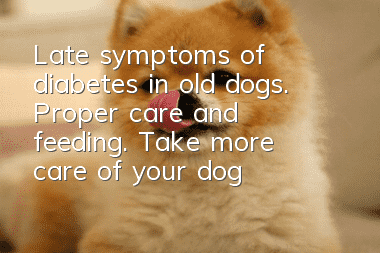Late symptoms of diabetes in old dogs. Proper care and feeding. Take more care of your dog.

Late-stage symptoms of diabetes in old dogs
Old dogs will have many complications when they suffer from late-stage diabetes. Symptoms may include kidney disease, myocardial infarction, cerebral infarction, ketoacidosis, etc. Different complications have different death symptoms, which are often accompanied by incontinence, convulsions, foaming at the mouth, difficulty breathing, etc. Finally, the breathing disappeared, the heart rate stopped, the body gradually became cold, and reached an irreversible state of death.Causes of Diabetes in Old Dogs
The reason why dogs suffer from diabetes is the lack of insulin in the body. This causes the dog’s body to be unable to metabolize sugar normally, so there is too much sugar in the dog’s blood. of glucose and the dog’s cells don’t have enough glucose. Just like in humans, there are two types of diabetes in dogs: Type 1 diabetes: This is a congenital disease also known as juvenile diabetes. Type 2 diabetes: It is an acquired disease that is caused by acquired factors. It is caused by dogs' dependence on insulin. It is also called insulin-dependent diabetes. This condition usually occurs in older dogs (between 7-10 years old).Methods for treating diabetes in old dogs:
Exercise is helpful in the treatment of type 2 diabetes. Exercise maintains a healthy weight, and increased blood flow increases your dog's body's use of insulin, further lowering blood sugar levels. Exercise should be done regularly. Irregular exercise can cause glucose levels in the blood to rise and fall, which can be harmful to dogs.Diabetic dogs should be fed foods containing carbohydrates. These foods cause a slow release of glucose over a period of time; and diabetic dogs eat large amounts of fiber. At the same time, in order to maintain proper body weight, dogs should be fed food with low fat content.
Owners of dogs with insulin-dependent diabetes must learn to inject insulin at home. In order to maintain the stability of the dog's blood glucose level, regular injections of insulin are crucial.
Insulins are basically divided into 3 categories, short-acting insulin, mid-term insulin, and long-term insulin. Working hours are 1-4 hours, 4 to 24 hours, and 8 to 28 hours respectively. Every dog's need for insulin injections is different, so some dogs may need two injections per day, while others may only need one injection per day. This usually requires a veterinary exam and periodic blood tests to adjust insulin doses to determine.
- How to tell if your dog is fat? Is your dog overweight?
- Will your dog catch a cold if you blow the air conditioner? What should you do if your dog catches a cold if you blow the air conditioner?
- The dog's mouth bites and shakes. Why does the dog's mouth occasionally shake and bite?
- How to cut a dog's hair? Do you know how to cut a dog's hair correctly?
- Can dogs eat raw eggs? Why can’t dogs eat egg whites?
- Common Dog Problems in Summer How to Deal with Different Dog Problems
- How to keep dogs away from skin diseases. If you do this, will you see if your dog will still be infected with skin diseases?
- What causes anorexia in dogs? Dogs will become anorexic due to lack of exercise. Hounds run at least 5KM every day.
- Can dogs eat liver? What should you pay attention to when giving liver to your dog?
- Can canine herpes virus be transmitted to humans? Owners should not be too nervous



